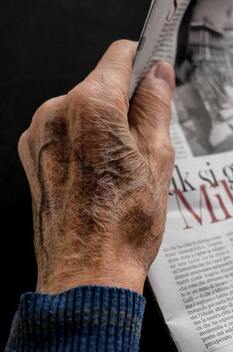
In the clinic we commonly hear people tell us their pain and stiffness gets worse in cold and damp weather conditions. So is there any science or explanation backing this common clinical finding?
Studies have shown between 62% and 97% of people with muscle and joint conditions report that the weather has an effect on their pain. However despite this common clinical report and belief, a relationship between weather and pain has been difficult to confirm... or negate.
One review paper indicated that the majority (67%) of studies they looked at found an association between pain and a weather variable (ie: temperature, barometric pressure, humidity and precipitation).
Barometric pressure is a measure that refers to the weight of the air. Some research has shown the change in barometric pressure has more effect on pain levels than the actual barometric pressure itself. So yes a change in the pressure (ie: a cold front or warm front coming in... Or in my Grandma’s case when the witch would come out of her little house) could explain the increase in achiness in your hip or your knee or your fingers.
Some studies have shown higher humidity or precipitation (wet weather) combined with colder temperatures has a greater effect on pain (when compared with high humidity and hotter temperatures). So yes that chill in the air might make those aches seem worse as well.
But what are the physical reasons behind the changes in our joints and muscles and, ultimately, our pain? Changes in barometric pressure have been theorized to cause tendons, muscles, bones and scar tissue to expand and contract, resulting in greater pain, stiffness or inflammation in tissues and joints affected by arthritis. Some theories suggest cooler temperatures may increase the thickness of synovial fluid in the joint resulting in greater stiffness and contributing to more pain. In elderly populations with arthritis, the effect of temperature changes on stiffness of a joint has also been shown to be greater.
With that being said, the evidence supporting these findings is mixed and there are other reasons that cold, damp weather may affect our symptoms. For example, when the weather is colder there may be a tendency to be less active than when the weather is warmer. There is strong evidence supporting physical activity as a means of relieving pain, especially chronic pain or arthritic pain. Therefore, inactivity related to colder weather could be a factor contributing to greater muscle or joint pain and stiffness.
So whether you are the one to examine the research out there or the one to trust your Grandma’s weather reports and the “cuckoo-clock like witch” on the wall, it is more important to know how to help yourself manage the muscle and joint pain, independent of the weather!
As we approach fall and you are preparing for the colder months ahead and looking for some safe, beneficial exercises to help you with your symptoms, we would be happy to help. If you have any questions, don’t hesitate to ask!
PS - did you know Donald Physiotherapy has therapists trained in GLA:D and Bonefit; two different programs that provide education and exercises to assist with the pain and stiffness that may be due to Arthritis - curious? Please ask us more!
Jacquie Russell, PT
References:
Beukenhorst, A et al. Are weather conditions associated with chronic musculoskeletal pain? Review of results and methodologies. [online] PAIN: April 2020 - Volume 161 - Issue 4 - p 668-683.
Deall C and Majeed H. Effect of Cold Weather on the Symptoms of Arthritic Disease: A Review of the Literature. [online] J Gen Pract Volume 4. Issue 5.
Arthritis Foundation. Living With Arthritis Blog. [online] http://blog.arthritis.org/living-with-arthritis/weather-arthritis-pain


 RSS Feed
RSS Feed